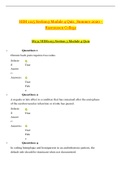College aantekeningen
Uitgebreide College Aantekeningen Organizational Culture and Change
- Instelling
- Vrije Universiteit Amsterdam (VU)
Uitgebreide college aantekeningen van het vak Organizational Culture and Change (2022/2023) inclusief aantekeningen over de behandelde films (movie analysis) en een aantal referenties naar de verplichte literatuur.
[Meer zien]














